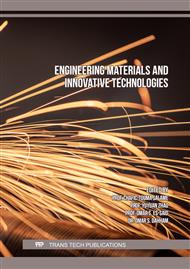[1]
M. M. Conde, O. Conde, J. M. Trillo, and J. J. Minones, Approach to Knowledge of the Interaction between the Constituents of Contact Lenses and Ocular Tears: Mixed Monolayers of Poly(methyl methacrylate) and Dipalmitoyl Phosphatidyl Choline,, Langmuir, vol. 27, p.3424–3435, (2011).
DOI: 10.1021/la1051172
Google Scholar
[2]
C. S. A. Musgrave and F. Fang, Contact lens materials: A materials science perspective,, Materials, vol. 12, no. 2. 2019.
Google Scholar
[3]
F. J. Al-Hasani, Studying the effect of cobalt percentage on the corrosion rate of sintered titanium dental implants,, AIP Conf. Proc., vol. 2190, no. December, 2019,.
DOI: 10.1063/1.5138497
Google Scholar
[4]
F. J. Al-Hasani, Evaluation of surface roughness and biological behavior of Ti-Nb alloys,, J. Mech. Eng. Res. Dev., vol. 43, no. 7, p.233–241, (2020).
Google Scholar
[5]
E. Al-Hassani, F. Al-Hassani, and M. Najim, Effect of polymer coating on the osseointegration of CP-Ti dental implant,, AIP Conf. Proc., vol. 1968, 2018,.
DOI: 10.1063/1.5039209
Google Scholar
[6]
F. Alipour, S. Khaheshi, M. Soleimanzadeh, S. Heidarzadeh, and F. E. Hospital, Review Article Contact Lens ‑ related Complications : A Review,, CLAO Journal. p.193–204, (2017).
Google Scholar
[7]
J. L. Alió, J. I. Belda, A. Artola, M. García-Lledó, and A. Osman, Contact lens fitting to correct irregular astigmatism after corneal refractive surgery,, Journal of Cataract and Refractive Surgery, vol. 28, no. 10. p.1750–1757, 2002.
DOI: 10.1016/s0886-3350(02)01489-x
Google Scholar
[8]
J. H. J. Thean and A. A. Mcnab, Blepharoptosis in RGP and PMMA hard contact lens wearers,, Clin. Exp. Optom., vol. 87, no. 1, p.11–14, 2004,.
DOI: 10.1111/j.1444-0938.2004.tb03139.x
Google Scholar
[9]
L. N. Subbaraman and M.-A. Glasier, Kinetics of In Vitro Lysozyme Deposition on Silicone Hydrogel, PMMA, and FDA Groups I, II, and IV Contact Lens Materials,, Curr. Eye Res., vol. 31, p.787–796, (2006).
DOI: 10.1080/02713680600888799
Google Scholar
[10]
J. Wang, D. Fonn, and T. L. Simpson, Topographical Thickness of the Epithelium and Total Cornea after Hydrogel and PMMA Contact Lens Wear with Eye Closure,, Invest. Ophthalmol. Vis. Sci., vol. 44, no. 3, p.1070–1074, (2003).
DOI: 10.1167/iovs.02-0343
Google Scholar
[11]
A. A. Shishavan, L. Nordin, P. Tjossem, M. D. Abramoff, and F. Toor, PMMA based ophthalmic contact lens for vision correction of strabismus., (2016).
DOI: 10.1117/12.2237994
Google Scholar
[12]
S. Li, M. S. Toprak, Y. S. Jo, J. Dobson, D. K. Kim, and M. Muhammed, Bulk synthesis of transparent and homogeneous polymeric hybrid materials with ZnO quantum dots and PMMA,, Advanced Materials, vol. 19, no. 24. p.4347–4352, 2007.
DOI: 10.1002/adma.200700736
Google Scholar
[13]
K. Đuro et al., Nanophotonic Rigid Contact Lenses: Engineering and Characterization,, Adv. Mater. Res., vol. 633, p.239–252, (2013).
Google Scholar
[14]
M. J. and L. M. M Tomić, J Munćan, D Stamenković, Biocompatibility and cytotoxicity study of nanophotonic rigid gas permeable contact lens material,, J. Phys. Conf. Ser. OPEN, vol. 419, no. 012016, p.1–10, (2013).
DOI: 10.1088/1742-6596/429/1/012016
Google Scholar
[15]
A. D. Mitrović, V. M. Miljković, D. P. Popović, and D. L. Koruga, MECHANICAL PROPERTIES OF NANOPHOTONIC SOFT CONTACT LENSES BASED ON POLY (2-HYDROHZETHIL METHACRYLATE) AND FULLERENES,, Struct. Integr. LIFE, vol. 16, no. 1, p.39–42, (2016).
Google Scholar
[16]
E. van der Worp, D. Bornman, D. L. Ferreira, M. Faria-Ribeiro, N. Garcia-Porta, and J. M. González-Meijome, Modern scleral contact lenses: A review,, Contact Lens and Anterior Eye, vol. 37, no. 4. p.240–250, 2014.
DOI: 10.1016/j.clae.2014.02.002
Google Scholar
[17]
R. Moreddu, D. Vigolo, and A. K. Yetisen, Contact Lens Technology: From Fundamentals to Applications,, Adv. Healthc. Mater., vol. 8, no. 15, p.1–24, 2019,.
DOI: 10.1002/adhm.201900368
Google Scholar
[18]
M. S. Khan, S. K. Yusufzai, L. Kimin, and N. A. N. B. Jabi, Determination of Chemical Composition, Total Flavonoid Content, Total Phenolic Content and Antioxidant Capacity of Various Crude Extracts of Manihot esculenta Crantz Leaves,, Int. J. Res. Appl. Sci. Eng. Technol., vol. 6, no. IV, p.2433–2443, (2018).
DOI: 10.22214/ijraset.2018.4413
Google Scholar
[19]
M. Jawadul, F. H. Brishti, and M. M. Hoque, Aloe vera gel as a Novel Edible Coating for Fresh Fruits: A Review,, American Journal of Food Science and Technology, vol. 2, no. 3. p.93–97, 2014.
DOI: 10.12691/ajfst-2-3-3
Google Scholar
[20]
D. Khatri, J. Panigrahi, A. Prajapati, and H. Bariya, Attributes of Aloe vera gel and chitosan treatments on the quality and biochemical traits of post-harvest tomatoes Dinesh,, Sci. Hortic. J., vol. 259, no. 108837, p.8, (2020).
DOI: 10.1016/j.scienta.2019.108837
Google Scholar
[21]
Y. Zhang, Z. Bao, X. Ye, and Z. Xie, Chemical Investigation of Major Constituents in Aloe vera Leaves and Several Commercial Aloe Juice Powders,, J. aoaC Int., vol. 101, no. 6, p.1741–1751, (2018).
DOI: 10.5740/jaoacint.18-0122
Google Scholar


